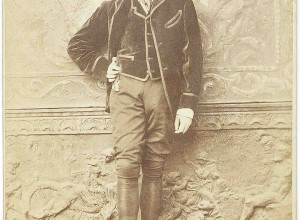Rediscovering the Books (and Book Covers) of Amelia E. Barr
 Apropos to a Salon article last week about women writers languishing in "moldy archives," I wanted to share the news about book artist Richard Minsky's newest collection and catalogue, The Books of Amelia E. Barr.
Apropos to a Salon article last week about women writers languishing in "moldy archives," I wanted to share the news about book artist Richard Minsky's newest collection and catalogue, The Books of Amelia E. Barr.
Barr was born in England in 1831 but emigrated to the U.S. when she was 23. She became a writer after her husband and six of her (nine) children died. She wrote primarily for women and was an influential supporter of women's rights. In total, she published seventy books.*
Minsky has put together six collections of American publishers' bindings over the past decade. He stumbled upon Barr's books while collecting in another area. In addition to the limited edition catalogue (of which he tells me there are only 8 left), Minsky is also offering the collection for sale en bloc. Its eventual acquistion by an institutional library is bound to kindle academic, if not popular, interest in Barr. I asked him more about his interest in her work and this project.
RRB: It is striking how 'lost to history' Barr was. When you started collecting her titles, did you intend to 'recover' her, or did that happen later in the process?
RM: It wasn't until I read her autobiography that I saw this as a compelling story, and developed the format where she describes each of the books in the exhibition. As I learned more I saw her importance not only as a popular author, but her narrative of the circumstances of writing, her interactions with publishers, and the letters from her readers, all appealed to me as a coherent study in book history. This complements the collection as a study in material culture and graphic design. What topped it off was her dramatic expository position on women's rights which, at a time when women were marching to get the vote, brought constitutional process into the mix. She reached out to women with this underlying theme set in the context of well-researched historical romance fiction.
The extent of her readership is indicated not only by the number of editions of her books. According to the "What Middletown Read" project, which documented the circulation of books in the Muncie, Indiana, Public Library from 1891 to 1902, Amelia Barr's Bernicia was borrowed 291 times. The library had eleven Barr books in that period, with 1,052 transactions by 667 patrons. If one extrapolates from that one small Midwest city library to the entire nation...
RRB: How long did the collecting & cataloguing take? Where did you do most of your buying?
RM: Books by Amelia Barr were in my first exhibition (2005-06), so in that sense it was over a decade. It took a year to do the research and write the catalogue. Most books were acquired over the Internet, and some were scouted for me by dealers.  RRB: Can you pinpoint something about her fiction that made it such a good fit for decorated bindings?
RRB: Can you pinpoint something about her fiction that made it such a good fit for decorated bindings?
RM: She wrote primarily for women, and much of it was historical romance novels, so there was a lot of room for floral and decorative work, as well as metaphoric and literal imagery.
RRB: In the past decade, you've done this kind of large-format collecting, exhibiting & cataloguing process 6 times (including Barr). Do you plan to do another?
RM: I didn't plan to do any of them--they grabbed me one way or another and were too compelling to ignore. Right now I'm working on a small-scale catalogue about The Unknown Modernist Master of 1879-1882. This is the artist responsible for Aboard the Mavis and the Bodley book covers that were decades ahead of their time.
*See also Richard's post yesterday on what would have been Barr's 185th birthday.
Images: Catalogue cover adapted from the 1897 William Snelling Hadaway design for Prisoners of Conscience. Courtesy of Richard Minsky. The Bell of Bowling Green, illustrated by Walter H. Everett, cover by Charles Buckles Falls (New York: Dodd, Mead & Co., 1908). Courtesy of Richard Minsky.















